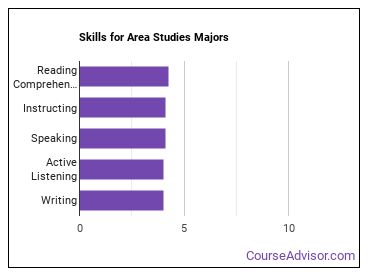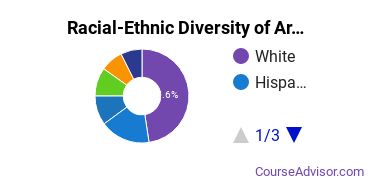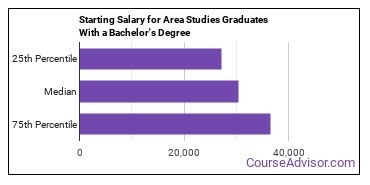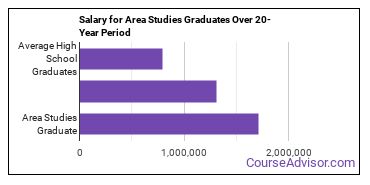Area Studies
Featured schools near , edit
Types of Degrees Area Studies Majors Are Getting
The following table lists how many area studies graduations there were in 2020-2021 for each degree level.
| Education Level | Number of Grads |
|---|---|
| Bachelor’s Degree | 4,550 |
| Master’s Degree | 1,450 |
| Basic Certificate | 377 |
| Doctor’s Degree | 244 |
| Associate Degree | 180 |
| Graduate Certificate | 131 |
| Undergraduate Certificate | 34 |
What Area Studies Majors Need to Know
In an O*NET survey, area studies majors were asked to rate what knowledge areas, skills, and abilities were important in their occupations. These answers were weighted on a scale of 1 to 5 with 5 being the most important.
Knowledge Areas for Area Studies Majors
According to O*NET survey takers, a major in area studies should prepare you for careers in which you will need to be knowledgeable in the following areas:

- Education and Training - Knowledge of principles and methods for curriculum and training design, teaching and instruction for individuals and groups, and the measurement of training effects.
- English Language - Knowledge of the structure and content of the English language including the meaning and spelling of words, rules of composition, and grammar.
- Sociology and Anthropology - Knowledge of group behavior and dynamics, societal trends and influences, human migrations, ethnicity, cultures and their history and origins.
- Foreign Language - Knowledge of the structure and content of a foreign (non-English) language including the meaning and spelling of words, rules of composition and grammar, and pronunciation.
- History and Archeology - Knowledge of historical events and their causes, indicators, and effects on civilizations and cultures.
Skills for Area Studies Majors
The following list of skills has been highlighted as some of the most essential for careers related to area studies:

- Reading Comprehension - Understanding written sentences and paragraphs in work related documents.
- Instructing - Teaching others how to do something.
- Speaking - Talking to others to convey information effectively.
- Active Listening - Giving full attention to what other people are saying, taking time to understand the points being made, asking questions as appropriate, and not interrupting at inappropriate times.
- Writing - Communicating effectively in writing as appropriate for the needs of the audience.
Abilities for Area Studies Majors
As you progress with your area studies degree, there are several abilities you should pick up that will help you in whatever related career you choose. These abilities include:

- Oral Expression - The ability to communicate information and ideas in speaking so others will understand.
- Written Expression - The ability to communicate information and ideas in writing so others will understand.
- Oral Comprehension - The ability to listen to and understand information and ideas presented through spoken words and sentences.
- Written Comprehension - The ability to read and understand information and ideas presented in writing.
- Speech Clarity - The ability to speak clearly so others can understand you.
What Can You Do With a Area Studies Major?
People with a area studies degree often go into the following careers:
| Job Title | Job Growth Rate | Median Salary |
|---|---|---|
| Area, Ethnic, and Cultural Studies Professors | 10.4% | $74,440 |
Who Is Getting a Bachelor’s Degree in Area Studies?
Racial-Ethnic Diversity
At the countrywide level, the racial-ethnic distribution of area studies majors is as follows:

| Race/Ethnicity | Number of Grads |
|---|---|
| Asian | 459 |
| Black or African American | 336 |
| Hispanic or Latino | 787 |
| White | 2,166 |
| International Students | 355 |
| Other Races/Ethnicities | 447 |
Geographic Diversity
Americans aren’t the only ones with an interest in Area Studies. About 7.8% of those with this major are international students. The most popular countries for students from outside the country are:
- China
- South Korea
- Japan
- United Kingdom
- Germany
How Much Do Area Studies Majors Make?
Bachelor’s Degree Starting Salary
The median early-career salary of area studies students with a bachelor’s degree is $30,421 a year according to 2019-2020 data from the U.S. Department of Education. During this timeframe, most salaries fell between $27,225 (25th percentile) and $36,522 (75th percentile).

One thing to note here is that not all of these people may be working in careers related to area studies.
Salaries According to BLS
The median salary for someone in a career related to area studies is $85,450. This median refers to all degree levels, so you may expect those with a more advanced degree to make more while those with less advanced degrees will typically make less.
To put that into context, according to BLS data from the first quarter of 2020, the typical high school graduate makes between $30,000 and $57,900 a year (25th through 75th percentile). The average person with a bachelor’s degree (any field) makes between $45,600 and $99,000. Advanced degree holders make the most with salaries between $55,600 and $125,400.
Amount of Education Required for Careers Related to Area Studies
Some careers associated with area studies require an advanced degree while some may not even require a bachelor’s. In general, the more advanced your degree the more career options will open up to you. However, there is significant time and money that needs to be invested into your education so weigh the pros and cons.
Find out what the typical degree level is for area studies careers below.

| Education Level | Percentage of Workers |
|---|---|
| High School Diploma - or the equivalent (for example, GED) | 0.2% |
| Master’s Degree | 31.5% |
| Post-Master’s Certificate - awarded for completion of an organized program of study; designed for people who have completed a Master’s degree but do not meet the requirements of academic degrees at the doctoral level. | 3.3% |
| First Professional Degree - awarded for completion of a program that: requires at least 2 years of college work before entrance into the program, includes a total of at least 6 academic years of work to complete, and provides all remaining academic requirements to begin practice in a profession. | 1.1% |
| Doctoral Degree | 61.6% |
| Post-Doctoral Training | 4.0% |
Online Area Studies Programs
In the 2020-2021 academic year, 506 schools offered some type of area studies program. The following table lists the number of programs by degree level, along with how many schools offered online courses in the field.
| Degree Level | Colleges Offering Programs | Colleges Offering Online Classes |
|---|---|---|
| Certificate (Less Than 1 Year) | 0 | 0 |
| Certificate (1-2 years) | 15 | 1 |
| Certificate (2-4 Years) | 4 | 0 |
| Associate’s Degree | 32 | 1 |
| Bachelor’s Degree | 89 | 4 |
| Post-Baccalaureate | 0 | 0 |
| Master’s Degree | 251 | 3 |
| Post-Master’s | 24 | 0 |
| Doctor’s Degree (Research) | 83 | 0 |
| Doctor’s Degree (Professional Practice) | 0 | 0 |
| Doctor’s Degree (Other) | 0 | 0 |
Is a Degree in Area Studies Worth It?
The median salary for a area studies grad is $85,450 per year. This is based on the weighted average of the most common careers associated with the major.
This is 114% more than the average salary for an individual holding a high school degree. This adds up to a gain of about $911,000 after 20 years!

Top Ranking Lists for Area Studies
Explore Major by State
Alabama
California
District of Columbia
Idaho
Kansas
Maryland
Mississippi
Nevada
New York
Oklahoma
South Carolina
Utah
West Virginia
Alaska
Colorado
Florida
Illinois
Kentucky
Massachusetts
Missouri
New Hampshire
North Carolina
Oregon
South Dakota
Vermont
Wisconsin
Majors Related to Area Studies
You may also be interested in one of the following majors related to area studies.
| Major | Number of Grads |
|---|---|
| Ethnic Studies | 9,231 |
| Ethnic, Culture, & Gender Studies (Other) | 46 |
References
*The racial-ethnic minorities count is calculated by taking the total number of students and subtracting white students, international students, and students whose race/ethnicity was unknown. This number is then divided by the total number of students at the school to obtain the racial-ethnic minorities percentage.
- College Factual
- College Scorecard
- National Center for Education Statistics
- O*NET Online
- U.S. Bureau of Labor Statistics
- Usual Weekly Earnings of Wage and Salary Workers First Quarter 2020
- Image Credit: By Karl Udo Gerth under License
More about our data sources and methodologies.
Featured Schools
 Request Info
Request Info
|
Southern New Hampshire University You have goals. Southern New Hampshire University can help you get there. Whether you need a bachelor's degree to get into a career or want a master's degree to move up in your current career, SNHU has an online program for you. Find your degree from over 200 online programs. Learn More > |

